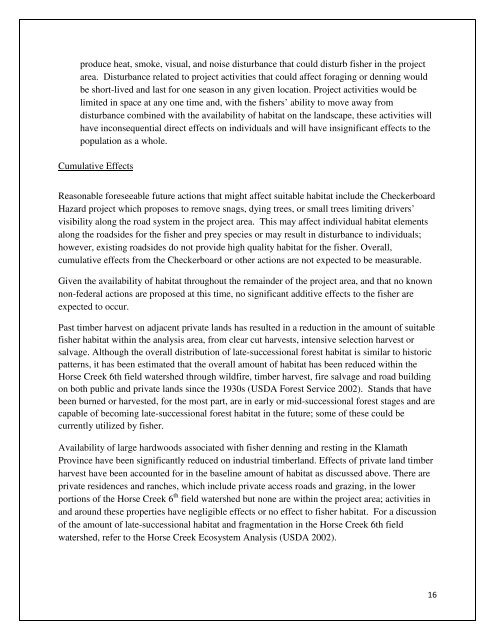Johnny O'Neil Late Successional Reserve Habitat Restoration and ...
Johnny O'Neil Late Successional Reserve Habitat Restoration and ...
Johnny O'Neil Late Successional Reserve Habitat Restoration and ...
You also want an ePaper? Increase the reach of your titles
YUMPU automatically turns print PDFs into web optimized ePapers that Google loves.
produce heat, smoke, visual, <strong>and</strong> noise disturbance that could disturb fisher in the project<br />
area. Disturbance related to project activities that could affect foraging or denning would<br />
be short-lived <strong>and</strong> last for one season in any given location. Project activities would be<br />
limited in space at any one time <strong>and</strong>, with the fishers’ ability to move away from<br />
disturbance combined with the availability of habitat on the l<strong>and</strong>scape, these activities will<br />
have inconsequential direct effects on individuals <strong>and</strong> will have insignificant effects to the<br />
population as a whole.<br />
Cumulative Effects<br />
Reasonable foreseeable future actions that might affect suitable habitat include the Checkerboard<br />
Hazard project which proposes to remove snags, dying trees, or small trees limiting drivers’<br />
visibility along the road system in the project area. This may affect individual habitat elements<br />
along the roadsides for the fisher <strong>and</strong> prey species or may result in disturbance to individuals;<br />
however, existing roadsides do not provide high quality habitat for the fisher. Overall,<br />
cumulative effects from the Checkerboard or other actions are not expected to be measurable.<br />
Given the availability of habitat throughout the remainder of the project area, <strong>and</strong> that no known<br />
non-federal actions are proposed at this time, no significant additive effects to the fisher are<br />
expected to occur.<br />
Past timber harvest on adjacent private l<strong>and</strong>s has resulted in a reduction in the amount of suitable<br />
fisher habitat within the analysis area, from clear cut harvests, intensive selection harvest or<br />
salvage. Although the overall distribution of late-successional forest habitat is similar to historic<br />
patterns, it has been estimated that the overall amount of habitat has been reduced within the<br />
Horse Creek 6th field watershed through wildfire, timber harvest, fire salvage <strong>and</strong> road building<br />
on both public <strong>and</strong> private l<strong>and</strong>s since the 1930s (USDA Forest Service 2002). St<strong>and</strong>s that have<br />
been burned or harvested, for the most part, are in early or mid-successional forest stages <strong>and</strong> are<br />
capable of becoming late-successional forest habitat in the future; some of these could be<br />
currently utilized by fisher.<br />
Availability of large hardwoods associated with fisher denning <strong>and</strong> resting in the Klamath<br />
Province have been significantly reduced on industrial timberl<strong>and</strong>. Effects of private l<strong>and</strong> timber<br />
harvest have been accounted for in the baseline amount of habitat as discussed above. There are<br />
private residences <strong>and</strong> ranches, which include private access roads <strong>and</strong> grazing, in the lower<br />
portions of the Horse Creek 6 th field watershed but none are within the project area; activities in<br />
<strong>and</strong> around these properties have negligible effects or no effect to fisher habitat. For a discussion<br />
of the amount of late-successional habitat <strong>and</strong> fragmentation in the Horse Creek 6th field<br />
watershed, refer to the Horse Creek Ecosystem Analysis (USDA 2002).<br />
16
















